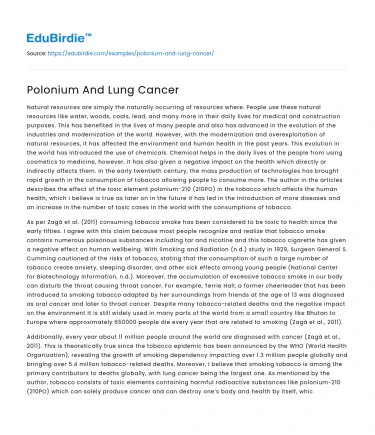Natural resources are simply the naturally occurring of resources where. People use these natural resources like water, woods, coals, lead, and many more in their daily lives for medical and construction purposes. This has benefited in the lives of many people and also has advanced in the evolution of the industries and modernization of the world. However, with the modernization and overexploitation of natural resources, it has affected the environment and human health in the past years. This evolution in the world has introduced the use of chemicals. Chemical helps in the daily lives of the people from using cosmetics to medicine, however, it has also given a negative impact on the health which directly or indirectly affects them. In the early twentieth century, the mass production of technologies has brought rapid growth in the consumption of tobacco allowing people to consume more. The author in the articles describes the effect of the toxic element polonium-210 (210PO) in the tobacco which affects the human health, which I believe is true as later on in the future it has led in the introduction of more diseases and an increase in the number of toxic cases in the world with the consumptions of tobacco.
As per Zagà et al. (2011) consuming tobacco smoke has been considered to be toxic to health since the early fifties. I agree with this claim because most people recognize and realize that tobacco smoke contains numerous poisonous substances including tar and nicotine and this tobacco cigarette has given a negative effect on human wellbeing. With Smoking and Radiation (n.d.) study in 1929, Surgeon General S. Cumming cautioned of the risks of tobacco, stating that the consumption of such a large number of tobacco create anxiety, sleeping disorder, and other sick effects among young people (National Center for Biotechnology Information, n.d.). Moreover, the accumulation of excessive tobacco smoke in our body can disturb the throat causing throat cancer. For example, Terrie Hall, a former cheerleader that has been introduced to smoking tobacco adapted by her surroundings from friends at the age of 13 was diagnosed as oral cancer and later to throat cancer. Despite many tobacco-related deaths and the negative impact on the environment it is still widely used in many parts of the world from a small country like Bhutan to Europe where approximately 650000 people die every year that are related to smoking (Zagà et al., 2011).
Additionally, every year about 11 million people around the world are diagnosed with cancer (Zagà et al., 2011). This is theoretically true since the tobacco epidemic has been announced by the WHO (World Health Organization), revealing the growth of smoking dependency impacting over 1.3 million people globally and bringing over 5.4 million tobacco-related deaths. Moreover, I believe that smoking tobacco is among the primary contributors to deaths globally, with lung cancer being the largest one. As mentioned by the author, tobacco consists of toxic elements containing harmful radioactive substances like polonium-210 (210PO) which can solely produce cancer and can destroy one’s body and health by itself, which is a major public health problem worldwide. Polonium-210 is an exceptionally poisonous component recognized as one of the dangers in human health that can easily kill a cell and can often be called a perfect poison (Recknagel, 2013). In the year 2006, Litvinenko a former Russian soldier was a victim of polonium-210 where he was diagnosed with rare syndromes that caused him to die later, upon investigation it was discovered that polonium-210 was present in the body causing him to die (MD, 2009).
In the early 20th century, lung cancer was an exceedingly rare illness, with almost no cases (Zagà et al., 2011). Similarly, in mid-1899 there were just 140 cases enlisted every year in the United States (Ruegg, 2015) whereas of now there are more than 480,000 death including 41,000 deaths coming about because of second-hand-smoking (“Smoking & Tobacco Use”, n.d.). Likewise, passive smoking is rising in the public health problem. With a large number of smokers, it has been affecting non-smokers in society despite keeping themselves away from the direct contact of such chemicals, they are widely being affected as a result of the smokers around those innocents. So, they directly or indirectly inhale polonium-210 which affects them in the long run.
To conclude, it is seen that tobacco influence humans wellbeing through the poisonous component polonium-210 leading to an expansion of harmful cases with the utilization of tobacco. The high absorption of toxic tobacco smoke in the body had also contributed to many risks, along with lung and throat cancer. The usage of polonium-210 in tobacco has been proven to be one of the dangerous elements to inhale or consume. This not only brings people fast deaths but also is introduced to diseases and destroys the body of the people. However, despite many people being a victim it is still used worldwide.
References
- Zagà, V., Lygidakis, C., Chaoua, K., & Gattavecchia, G. (2011, June). Polonium and lung Cancer. Journal of Oncology,1-5. Retrieved from https://www.hindawi.com/journals/jo/2011/860103/
- Recknagel, C. (2013, November 13). Five Things You Should Know About Polonium. Retrieved from https://www.rferl.org/a/polonium-facts/25161473.html?fbclid=IwAR0iixdKSTKL52fZe-_V7o60otuyEB0lWjYu5Lk8TqDD8NnO2WfDQxEMPjw
- Ruegg, T. A. (2015, May 14). Historical Perspectives of the Causation of Lung Cancer. National Center for Biotechnology Information. Retrieved from https://www.ncbi.nlm.nih.gov/pmc/articles/PMC5342645/
- Smoking & Tobacco Use: Tobacco-Releated Mortality. (n.d.). Centers for Disease Control and Prevention. Retrieved from https://www.cdc.gov/tobacco/data_statistics/fact_sheets/health_effects/tobacco_related_mortality/index.htm
- Radiation and Your Health: Cigarette Smoking and Radiation. (n.d.). Centers for Disease Control and Prevention. Retrieved from https://www.cdc.gov/nceh/radiation/smoking.htm
- National Center for Biotechnology Information. (n.d.). The Health Consequences of Smoking. 50 Years of Progress: A Report of the Surgeon General. Retrieved from https://www.ncbi.nlm.nih.gov/books/NBK294310/?fbclid=IwAR3zW_k4jfz5JfhMwyXq-zfiOuIA3SiBV8ByttCs35bQaDJqsbODKixt96w
- MD, J. B. (2009, March). ). Death by polonium-210: Lessons learned from the murder of former Soviet spy Alexander Litvinenko. Research Gate. Retrieved from https://www.researchgate.net/publication/24206298_Death_by_polonium-210_Lessons_learned_from_the_murder_of_former_Soviet_spy_Alexander_Litvinenko






 Stuck on your essay?
Stuck on your essay?

